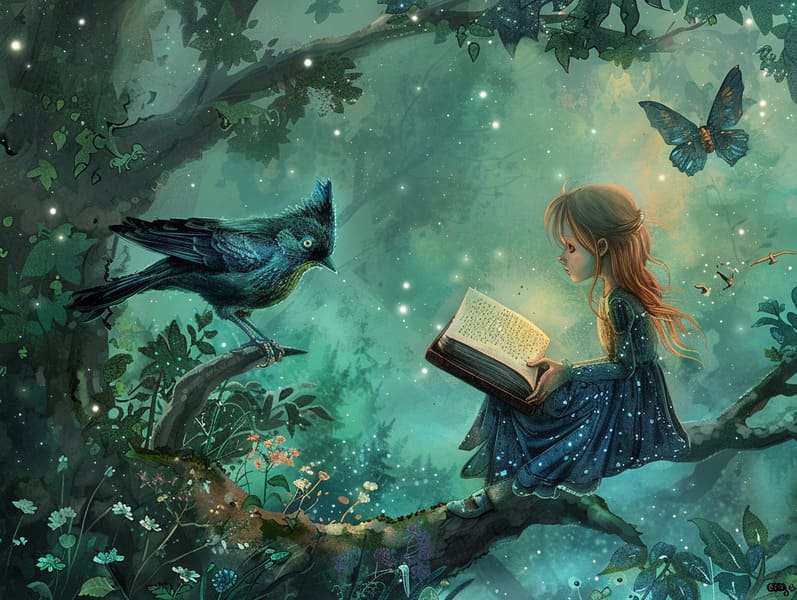
Children's fairy tales have enduring presence. These tales have been narrated from one generation to the next ages before they were ever published. They were born from a variety of cultures, including Middle Eastern traditions. They were initially told among older generations, often carrying themes and messages pertaining to the societal norms and beliefs of the time.
The famous Grimm duo, Jacob and Wilhelm Grimm, were among the first to assemble many of these beloved stories. Their compilation, "Grimm's Children's Stories," included tales like "The True Bride," "Hansel and Grethel," and "Little Snow White," which have since become mainstays in the world of children's fairy tales. Similarly, H. C. Andersen's enchanting stories, such as "The Little Mermaid," and "The Ugly Duckling," have gained the love worldwide, guaranteeing their place in the pantheon of timeless fairy tales.
Though they are old, traditional fairy tales remain as relevant as ever, especially as bedtime stories for kids. These fantastical tales are now available in different formats, including richly illustrated books, fantastical animations, and web-based fairy tales.
Their lasting presence can be traced to several fascinating points:
Significant Morals: Timeless fairy tales often whisper important moral lessons. Stories like "The Shepherd Boy and the Wolf" teach the benefit of truthfulness, while "The Tale of the Tortoise and the Hare" point out the merits of perseverance and modesty. These narratives offer the young clear distinctions between moral and immoral, developing their moral compass in a kind yet impactful way.
Kindness and Comprehension: Old fairy tales frequently showcase personalities facing problems and hurdles, motivating readers to comprehend with their struggles and celebrate their triumphs. For instance, "The Story of Beauty and the Beast" highlights the benefit of seeing beyond looks to perceive the inner spirit of a being, encouraging sympathy and comprehension.
Cultural Insights: Many classic fairy tales are interwoven with the cultural contexts from which they bloomed. Engaging with these fairy tales can provide delightful insights into different heritages, promoting a sense of global understanding and respect.
Inventiveness and Imagination: The enchanted elements in timeless fairy tales—magical beings—fuel children’s inventiveness. These tales guide readers to imaginary realms, triggering creative dreams and a sense of delight that lasts a lifetime.
Traditional fairy tales are not only fascinating but also educational. They function as enchanted tools in promoting various mental and emotional abilities in little ones. When traditional fairy tales are spoken, they promote verbal skills by teaching new words and intricate sentence structures. This practice also strengthens listening skills and attention span, as children listen intently, anticipating to see what happens next.
Furthermore, conversing about the themes and characters of classic fairy tales can improve reasoning skills and reasoning skills. Young readers are led to detect patterns, forecast, and make sense of cause and effect. These reflections also contribute to young ones speak out their thoughts and feelings, boosting their emotional intelligence.
In today’s cyber age, the existence of online fairy tales has made these tales more accessible than ever. Online platforms and web apps provide comprehensive collections of timeless fairy tales that can be perused or played anytime, anywhere. Fairy tales narrated are particularly well-liked, extending an captivating way for little ones to savor these enchanting tales. Audiobooks and read-aloud videos bring characters and settings to life, often augmented by delightful harmonies and harmonies that enhance the tale journey.
The timeless charm of classic fairy tales lies in their ability to change to the present while keeping hold of their basic principles. Contemporary reimaginings of these fairy tales often feature more inclusive characters and modern settings, making them meaningful to today’s audience. However, the underlying themes of valor, kindness, and justice remain unchanged, continuing to appeal to listeners of all ages.
Old fairy tales also offer a sense of contentment and closeness. They bequeath a organized narrative with a distinct beginning, middle, and end, often finishing with the finalization of conflicts and the triumph of good over evil. This regularity can be placating for young readers, sharing a sense of stability in an inconstant world.
Timeless fairy tales continue to entrance and guide new generations, maintaining their magic and relevance in modern society. As children's bedtime stories, they bring a perfect blend of charm and understanding, aiding moral values, empathy, and creativity. The prevalence of online storybooks and the likability of fairy tales spoken assure that these old narratives remain available to new generations.
By holding onto and conveying these narratives, we continue to commemorate the rich tapestry of fantasy and cultural heritage. Whether you are perusing a vividly illustrated book, delving into a online library, or playing an voice book, the wonder of old fairy tales is always within reach. These tales demonstrate of the immortal nature of tales and its ability to gather us across eras and regions.
Be it you are seeing a gorgeously illustrated book, viewing a web collection, or listening to an read-aloud book, the elegance of famous fairy tales fairy tales is always within reach.
These tales point out of the unchanging magic of storytelling and its ability to join us across epochs and places, making a tie that delights and instructs alike.